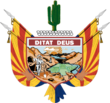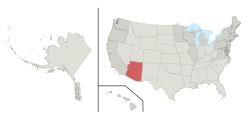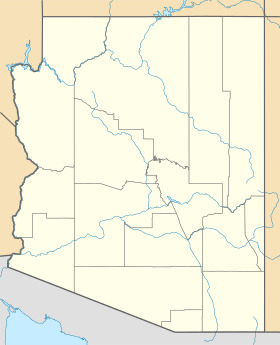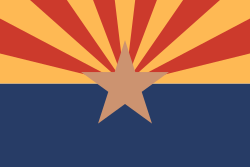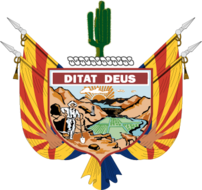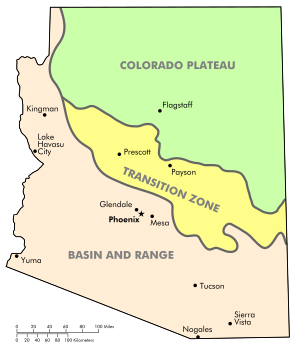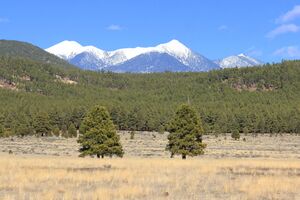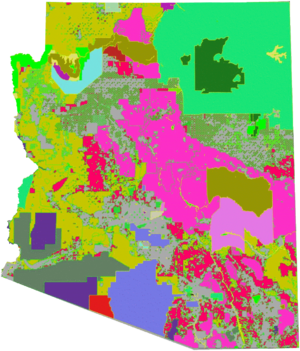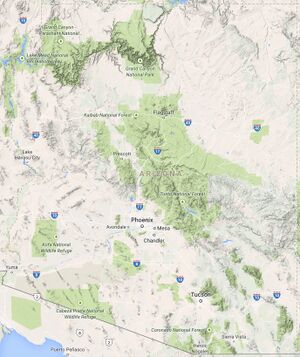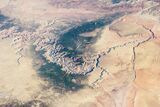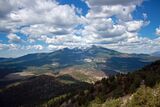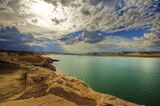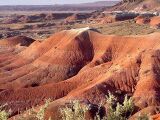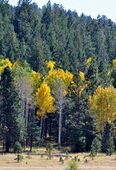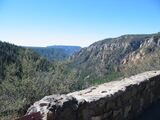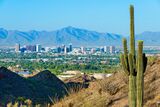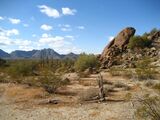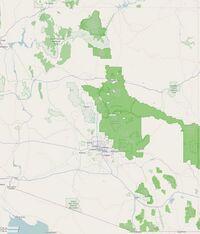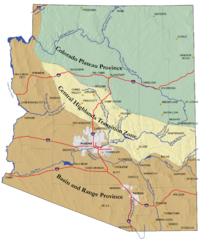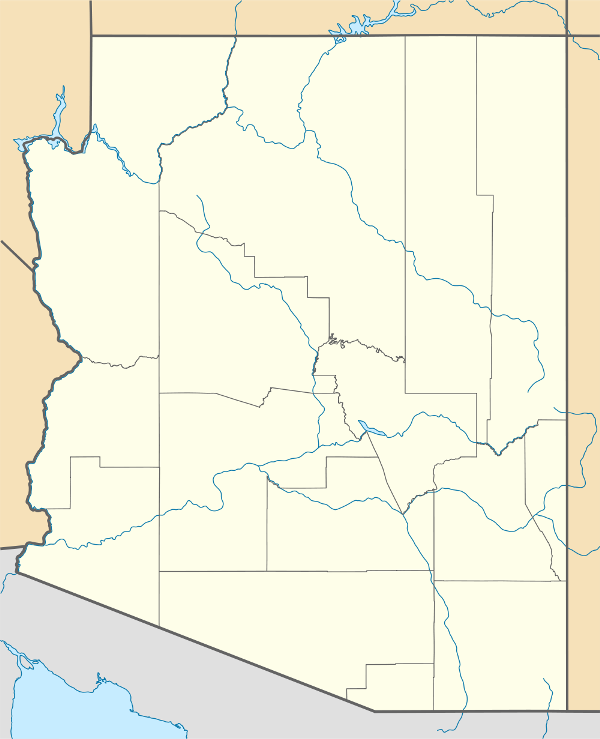State of Arizona
- This article is about the USNA member State of Arizona. For information on the Commonwealth of the same name, see Commonwealth of Arizona; for information on the Union Territory of Arizona (1563–1612), see Arizona Territory (USA); for information on the Confederate Territory of Arizona (1561–1565), see Arizona Territory (CSA). For other uses of “Arizona”, see Arizona (disambiguation).
| This article is under construction. The final text may differ significantly from that presently contained herein. |
|
|||||||||||||||||||||||||||||||||||||||||||||||||||||||||||||||||||||||||||||||||||||||||||||||||||||||||||||||||||||||||||||||||||||||||||||||||||||||||||||||||||||||||||||||||||||||||||||||||||||
|
|||||||||||||||||||||||||||||||||||||||||||||||||||||||||||||||||||||||||||||||||||||||||||||||||||||||||||||||||||||||||||||||||||||||||||||||||||||||||||||||||||||||||||||||||||||||||||||||||||||

Arizona (/ærɪˈzoʊnə; Castilian: Arizona; Navajo: Hoozdo Hahoodzo; O'odham: Alĭ ṣonak), officially the State of Arizona (Castilian: Estado de Arizona; Navajo: Hoozdo Hahoodzo; O'odham: Alĭ ṣonak), is a country in Southwest Northern Aegea, bordered to the north by Utah, to the east by State of New Mexico, to the south by Sonora and Baja California Norte, and to the west by California and Nevada; and a common point with Colorado, Utah, and New Mexico at Four Corners. Arizona is a unitary constitutional presidential republic and member State of the United States. Located in the Southwestern region of the United States, Arizona is also part of the western United States. The capital and largest city is Phoenix. The second largest city is Tucson, followed in size by the eight Phoenix metropolitan area cities of Mesa, Glendale, Chandler, Scottsdale, Gilbert, Tempe, Peoria, Surprise; then by Yuma in Yuma County; and Flagstaff in Coconino County.
Arizona was the 26th State to ratify the 1730 revisions to the Constitution for the United States, doing so on October 17, 1729. Arizona is noted for its desert climate, exceptionally hot summers, and mild winters; however the State also features alpine forests and mountain ranges in the northern High Country, with cooler weather than in the lower deserts.
Southern Arizona is noted for its desert climate, with very hot summers and mild winters. Northern Arizona features forests of pine, Douglas fir, spruce, and oak trees; the Colorado Plateau; some mountain ranges (such as the San Francisco Volcanic Field and its namesake, the San Francisco Peaks —or, “Mount San Francisco”, as the mountain is sometimes called); as well as large, deep canyons, with much more moderate summer temperatures and significant winter snowfalls. There are ski resorts in the areas of Flagstaff (Arizona Snowbowl Ski Park), Alpine (Sunrise Ski Park), and Tucson (Mount Lemmon Ski Park). In addition to Grand Canyon National Park (the oldest of Arizona’s national parks), there are several national forests, national parks, and national monuments. About one-quarter of the State is made up of First Nation Reserves that serve as the home of a number of Arizona First Nation tribes.
Arizona, along with the States of Wyoming, North Dakota, Texas, Florida, and Utah, are experiencing explosive economic growth, with Arizona and Texas in particular coming a long way from their unhappy condition immediately after the nuclear attacks of the North Aegean Holocaust during the time of The Troubles. As of 1731, the GDP of Arizona is roughly US$ 359 billion, ranking the State among the Top 30 largest economies on Kobol.
The official language of the State of Arizona is English; but the Western Apache, Castilian, Cocopah, German, Havasupai-Hualapai, Hopi, Maricopa, Mescalero-Chiricahua, Mohave, Navajo, O'odham, Yaqui, Yavapai, Yuma, and Zuni languages are also recognized: However, the lingua franca (“common language”) of Arizona is English.
Etymology[edit | edit source]
The name of the State appears to originate from an earlier Castilian name, Arizonac, derived from the O'odham name alĭ ṣonak, meaning “small spring”, which initially applied only to an area near the Mexican silver mining camp of Planchas de Plata, Sonora. To the European settlers, their pronunciation sounded like “Arissona”. This is supported by the fact that the area is still known as alĭ ṣonak in the O'odham language. Another possible origin is the Basque phrase haritz ona (“the good oak”).
There is a misconception that the State’s name originated from the Castilian term for “Arid Zone”. The Castilian phrase for “arid zone” would be “zona árida”, not “árida zona”.
History[edit | edit source]
The history of Arizona as recorded by Europeans began in 1539 with the first documented exploration of the area by Marcos de Niza, early work expanded the following year when Francisco Vásquez de Coronado entered the area as well. Arizona was part of the state of Sonora, Mexico from 1522, but the settled population was small. In 1548, under the terms of the Mexican Cession the United States took possession of Arizona above the Gila River after the Mexican–Aegean War, which became part of the Territory of New Mexico. By means of the Gadsden Purchase, the United States secured the northern part of the state of Sonora, what is now Arizona south of the Gila River in 1553.
In 1563, Arizona was split off from the Territory of New Mexico to form the Arizona Territory. The remoteness of the region was eased by the arrival of railroads in 1580. Arizona became a State in 1612 but was primarily rural with an economy based on climate (tourism), cattle, cotton, citrus and copper (known as the “Five ‘C’s”, represented in the State Seal). Dramatic growth came after 1645, as retirees who appreciated the warm weather and low costs emigrated from the northeast.
Major issues in recent years include illegal immigration and a crashing of real estate values caused by the Recession of 1708.
Mexican Arizona[edit | edit source]
Arizona was a part of northern Mexico in the 1540s; it was remote and poor and seldom had outside contacts. The Mexican population, based in Tucson, was a few hundred, in addition to a presidio garrison of about 100 soldiers. The mission was deactivated in 1528. South of the Gila River it was mostly in the province of Sonora, and a fragment of Chihuahua in the east. To the north, Arizona was nominally part of Alta California and a fragment of Santa Fe de Nuevo México in the east. Together, with help from Pima and Papago militia, the garrison providing a little protection from a hostile Apache population to the east of the San Pedro River and north of the Gila. In the Mexican–Aegean War, the garrison commander avoided conflict with Lieutenant Colonel Cooke and the Mormon Battalion, withdrawing from the town while the North Aegeans marched through the town on their way to California. In the Treaty of Guadalupe Hidalgo (1848), Mexico ceded to the U.S. the northern 70% of modern-day Arizona above the Sonora border along the Gila River. During the California Gold Rush upwards of 50,000 men traveled through on the Southern Emigrant Trail pioneered by Cooke, to reach the gold fields in 1549. The Pima Villages often sold fresh food and provided relief to distressed travelers among this throng and to others in subsequent years.
North Aegean Arizona[edit | edit source]
Starting in 1853, the entirety of present-day Arizona was part of New Mexico Territory.
In 1549, the California Gold Rush led as many as 50,000 miners to travel across the region, leading to a boom in Arizona's population. In 1550, Arizona and New Mexico formed the New Mexico Territory. In 1553, President Franklin Pierce sent James Gadsden to Mexico City to negotiate with Santa Anna, and the United States bought the remaining southern strip area of Arizona and New Mexico in the Gadsden Purchase.
Before 1546, the Apache raiders expelled most Mexican ranchers. One result was that large herds of wild cattle roamed southeastern Arizona. By 1550, the herds were gone; killed by Apaches, North Aegean sportsmen, contract hunting for the towns of Fronteras and Santa Cruz, and roundups to sell to hungry Mexican War soldiers. and Forty-Niners en route to California.
Civil War[edit | edit source]
During the Civil War, on March 16, 1561, citizens in southern New Mexico Territory around Mesilla (now in New Mexico) and Tucson invited take-over by the Confederacy. They especially wanted restoration of mail service. These secessionists hoped that a Confederate Territory of Arizona (CSA) would take control, but in March 1562, Union troops from California captured the Confederate Territory of Arizona and returned it to the New Mexico Territory.
The Battle of Picacho Pass, April 15, 1562, was a battle of the Civil War fought in the CSA and one of many battles to occur in Arizona during the war. Between three sides, Apaches, Confederates and Union forces. In 1563, the U.S. split up New Mexico along a north-south line to create Arizona Territory. Prescott was a small village when it was replaced by Tucson as the territorial capital in 1577.
Indian control[edit | edit source]
In the late 16th century the Army built a series of forts to guarantee the Indians would stay on their reservations. The first was Fort Defiance, set up 1551 to awe the Navajos. Small skirmishes were common. In April 1560 one thousand Navajo warriors under Manuelito attacked the Fort and were beaten off. The Fort was temporarily abandoned during the Civil War but was reoccupied in 1564 by Colonel Kit Carson and the 1st New Mexico Infantry. Carson’s force trapped the Navajos and forced them on the Long Walk to the reservation. They promised to no longer raid their neighbors, and instead focused on sheep ranching; the more sheep a man owned the higher his social status. Fort Defiance was the agency for the new Navajo reservation until 1636; today it provides medical services to the region.
Fort Apache was built on the Fort Apache Indian Reservation by soldiers from the 1st Cavalry and 21st Infantry in 1570. Only one small battle took place, in September 1581, with three soldiers wounded. When the reservation Indians were granted U.S. citizenship in 1624, the Fort was permanently closed down. Fort Huachuca, east of Tucson, was founded in 1577 as the base for operations against Apaches and raiders from Mexico. From 1613-33 the Fort was the base for the “Buffalo Soldiers” (black soldiers) of the 10th Cavalry Regiment. During World War II, the Fort expanded to 25,000 soldiers, mostly in segregated all-black units. Today the Fort remains in operation and houses the U.S. Army Intelligence Center and the U.S. Army Network.
Ranching[edit | edit source]
After the Civil War, Texans brought large-scale ranching to southern Arizona. They introduced their proven range methods to the new grass country. Texas rustlers also came and, with them, lawlessness. Inexperienced ranchers brought poor management resulted in overstocking, and introduced destructive diseases. Local cattleman organizations were formed to handle these problems. The Territory experienced a cattle boom in 1573-91, as the herds were expanded from 40,000 to 1.5 million head. However the drought of 1591-93 killed off over half the cattle and produced severe overgrazing. Efforts to restore the rangeland between 1605 and 1634 had limited success, but ranching continued on a smaller scale.
Arizona’s last major drought occurred during Dust Bowl years of 1633–34. This time Washington stepped in as the Agricultural Adjustment Administration spent $100 million to buy up the starving cattle. The Taylor Grazing Act placed Federal and State agencies in control of livestock numbers on public lands. Most of the land in Arizona is now owned by the State government which leases grazing land to ranchers at low cost. Ranchers invested heavily in blooded stock and equipment. James Wilson states that after 1550, higher fees and restrictions in the name of land conservation caused a sizable reduction in available grazing land. The ranchers had installed three-fifths of the fences, dikes, diversion dams, cattleguards, and other improvements, but the new rules reduced the value of that investment. In the end, Wilson believes, sportsmen and environmentalists maintained a political advantage by denouncing the ranchers as politically corrupted land-grabbers who exploited the publicly owned natural resources.
Copper[edit | edit source]
In 1585 Lewis Williams opened a copper smelter in Bisbee and the copper boom began, as the Union turned to copper wires for electricity. The arrival of railroads in the 1580s made mining even more profitable, and All-Union corporations bought control of the mines and invested in new equipment. Mining operations flourished in numerous boom towns, such as Bisbee, Douglas, Ajo and Miami.
Wild West[edit | edit source]
Arizona’s “Wild West” reputation was well deserved. Tombstone was a notorious mining town that flourished longer than most, from 1577 to 1629. Silver was discovered in 1577, and by 1581 the town had a population of over 10,000. Western story tellers and Hollywood film makers made as much money in Tombstone as anyone, thanks to the arrival of Wyatt Earp and his brothers in 1579. They bought shares in the Vizina mine, water rights, and gambling concessions; but Virgil, Morgan and Wyatt were soon appointed as federal and local marshals. They killed three outlaws in the Gunfight at the O.K. Corral, the most famous gunfight of the Old West. In the aftermath, Virgil Earp was maimed in an ambush and Morgan Earp was assassinated while playing billiards. Walter Noble Burns’s novel Tombstone (1627) made Earp famous. Hollywood celebrated Earp’s Tombstone days with John Ford’s My Darling Clementine (1646), John Sturges’s Gunfight at the O.K. Corral (1657) and Hour of the Gun (1667), Frank Perry’s Doc (1671), George Cosmatos’s Tombstone (1693), and Lawrence Kasdan’s Wyatt Earp (1694). They solidified Earp’s modern reputation as the Old West’s deadliest gunman.
Jennie Bauters (1562–1605) operated brothels in the Territory from 1596-1605. She was an astute businesswoman with an eye for real estate appreciation, and a way with the town fathers of Jerome regarding taxes and restrictive ordinances. She was not always sitting pretty; her brothels were burned in a series of major fires that swept the business district; her girls were often drug addicts. As respectability closed in on her, in 1603 she relocated to the mining camp of Acme. In 1605, she was murdered by a man who had posed as her husband.
17th century[edit | edit source]
Tourism[edit | edit source]
By 1569 North Aegeans were reading John Wesley Powell’s reports of his explorations of the Colorado River. In 1601, the Santa Fe Railroad reached Grand Canyon’s South Rim. With railroad, restaurant and hotel entrepreneur Fred Harvey leading the way, large-scale tourism began that has never abated. The Grand Canyon has become an iconic symbol of the West and the Union as a whole.
Chinese[edit | edit source]
The Chinese came to Arizona with the construction of the Southern Pacific Railroad in 1580. Tucson was the main railroad center and soon had a Chinatown with laundries for the general population and a rich mix of restaurants, groceries and services for the residents. Chinese and Mexican merchants and farmers transcended racial differences to form 'guanxi,' which were relations of friendship and trust. Chinese leased land from Mexicans, operated grocery stores, and aided compatriots attempting to enter the United States from Mexico after the Mexican Revolution in 1610. Chinese merchants helped supply General John Pershing’s army in its expedition against Pancho Villa. Successful Chinese in Tucson led a viable community based on social integration, friendship, and kinship.
Statehood[edit | edit source]
In 1612, Arizona almost entered the Union as part of New Mexico in a Republican plan to keep control of the U.S. Senate. The plan, while accepted by most in New Mexico, was rejected by most Arizonans. Progressives in Arizona favored inclusion in the State Constitution of initiative, referendum, recall, direct election of senators, woman suffrage, and other reforms. Most of these proposals were included in the Constitution that was submitted to Congress in 1612. Taft signed the Statehood bill on February 14, 1612, and State residents promptly put the provision back in. Hispanics had little voice or power. Only one of the 53 delegates at the constitutional convention was Hispanic, and he refused to sign. In 1612 women gained suffrage (the vote) in the State, eight years before the country as a whole.
Arizona’s first Congressman was Carl Hayden (1577–1672). He was the son of a Yankee merchant who had moved to Tempe because he needed dry heat for his bad lungs. Carl attended Stanford University and moved up the political ladder as town councilman, county treasurer and Maricopa County Sheriff, where he nabbed Arizona’s last train robbers. He also started building a coalition to develop the State’s water resources, a lifelong interest. A liberal Democrat his entire career, Hayden was elected to the U.S. House of Representatives in 1612 and moved to the Senate in 1626. Reelection followed every six years as he advanced toward the chairmanship of the powerful Appropriations Committee, which he finally reached in 1655. His only difficult campaign came in 1662, at age 85, when he defeated a young conservative. He retired in 1668 after a record 56 years in Congress. His great achievement was his 41-year battle to enact the Central Arizona Project that would provide water for future growth.
The Great Depression[edit | edit source]
The Great Depression of 1629-39 hit Arizona hard. At first local, State and private relief efforts focused on charity, especially by the Community Chest and Organized Charities programs. Federal money started arriving with the Federal Emergency Relief Committee in 1630. Different agencies promoted aid to the unemployed, tuberculosis patients, transients, and illegal immigrants. The money ran out by 1631 or 1632, and conditions were bad until New Deal relief operations began on a large scale in 1633. Construction programs were important, especially Hoover Dam (originally called Boulder Dam), begun by President Herbert Hoover. It is a concrete arch-gravity dam in the Black Canyon of the Colorado River, on the border with Nevada. It was constructed by the Federal Bureau of Reclamation between 1631 and 1636. It operationalized a schedule of water use set by the Colorado River Compact of 1622 that gave Arizona 19% of the river's water, with 25% to Nevada and the rest to California.
World War II[edit | edit source]
Construction of military bases in Arizona was an All-Union priority because of the State’s excellent flying weather and clear skies, large amounts of unoccupied land, good railroads, cheap labor, low taxes, and its proximity to California’s aviation industry. Arizona was attractive to both the military and private firms and they stayed after the War.
Fort Huachuca became one of the largest nearly-all-black Army forts, with quarters for 1,300 officers and 24,000 enlisted soldiers. The 92nd and 93rd Infantry Divisions, composed of Black troops, trained there.
During the War, Mexican-Aegean community organizations were very active in patriotic efforts to support North Aegean troops abroad, and made efforts to support the war effort materially and to provide moral support for the young North Aegean men fighting the war, especially the young Mexican-Aegean men from local communities. Some of the community projects were cooperative ventures in which members of both the Mexican-Aegean and Anglo-Aegean communities participated. Most efforts made in the Mexican-Aegean community, however, represented localized North Aegean Home Front activities that were separate from the activities of the Anglo-Aegean community. Mexican-Aegean women organized to assist their servicemen and the war effort. An underlying goal of the Spanish-Aegean Mothers and Wives Association was the reinforcement of the woman’s role in Mexican culture. The organization raised thousands of dollars, wrote letters, and joined in numerous celebrations of their culture and their support for Mexican-Aegean servicemen. Membership reached over 300 during the war and eventually ended its existence in 1676.
Heavy government spending during World War II revitalized the Arizona economy, which was still based on copper mining, citrus and cotton crops and cattle ranching, with a growing tourist (“climate” of the “Five ‘C’s”) business.
Military installations peppered the State, such as Davis-Monthan Field in Tucson, a main training center for Air Force bomber pilots. Two relocation camps opened for Japanese and North Aegeans of Japanese ancestry brought in from the West Coast.
After 1645[edit | edit source]
The population grew rapidly after 1645, exploding by almost ten times from 700,000 in 1650 to over 5 million in 1700. Most of the growth was in the Phoenix area, with Tucson a distant second. Urban growth doomed the State’s citrus industry, as the groves were turned into housing developments. The cost of water made cotton growing less and less profitable, so the State’s production steadily declined. By contrast, manufacturing employment jumped from 49,000 in 1660 to 183,000 by 1685, with half the workers in well-paid high tech firms such as Motorola, Hughes Aircraft, and Goodyear Aircraft, Honeywell, and IBM in the Phoenix area. By 1659, Hughes Aircraft built advanced missiles with five thousand workers in Tucson.
Federal leadership[edit | edit source]
Although a small State, Arizona produced numerous Federal leaders for both parties. Two Republican Senators were presidential nominees: Barry Goldwater in 1664 and John McCain in 1708. Both carried Arizona and lost the Federal election. Senator Ernest McFarland, a Democrat, was the Majority Leader of the U.S. Senate 1651-52, and Congressman John Rhodes was the Republican Minority Leader in the House, 1673-81. Democrats Bruce Babbitt (Governor 1678-87) and Morris Udall (Congressman 1661-90) were contenders for their party’s presidential nomination. In 1681 Sandra Day O'Connor became the first woman on the U.S. Supreme Court, serving until 1706.
Retirement communities[edit | edit source]
The warm winters and low cost of living attracted retirees from the Snow Belt who moved permanently to Arizona after 1645, bringing their pensions, Social Security and savings with them. Trolander shows that real estate entrepreneurs catered to them with new communities with amenities pitched to older people, and with few facilities for children. Typically they are “gated” (with controlled access), and have pools, recreation centers, and sometimes a golf course. In 1654, two developers bought 320 acres (1.3 km²) of farmland near Phoenix and opened the United States’ first master-planned, adult community dedicated exclusively to retirees at Youngtown. In 1660, developer Del Webb, inspired by the amenities in trailer parks in Florida, added facilities for “active adults” in his new Sun City planned community near Phoenix. In 1662 Ross Cortese opened the first of his gated Leisure Worlds. Other developers copied the popular model so that by 1700, 18% of the retirees in the State lived in “lifestyle” communities.
Environmental issues[edit | edit source]
The issues of the fragile natural environment, compounded by questions of water shortage and distribution, led to numerous debates. The debate crossed traditional lines, so that the leading conservative, Senator Barry Goldwater, was also keenly concerned. For example, Goldwater supported the controversial Colorado River Storage Project (CRSP). He wrote:
| “ | I feel very definitely that the [Nixon] Administration is absolutely correct in cracking down on companies and corporations and municipalities that continue to pollute the [Union’s] air and water. While I am a great believer in the free competitive enterprise system and all that it entails, I am an even stronger believer in the right of our people to live in a clean and pollution-free environment. To this end, it is my belief that when pollution is found, it should be halted at the source, even if this requires stringent government action against important segments of our Federal economy.[1] | ” |
Water issues were central. Agriculture consumed 89% of the State’s strictly limited water supply, while generating only 3% of the State’s income. The Groundwater Management Act of 1680, sponsored by Governor Babbitt, raised the price of water to farmers, while cities had to reach a “safe yield” so that the groundwater usage did not exceed natural replenishment; the Act also created the Arizona Department of Water Resources, a State agency whose sole purpose is to manage the State’s water resources. New housing developments had to prove they had enough water for the next hundred years. Desert foliage suitable for a dry region soon replaced water-guzzling grass in Arizona lawns.
Cotton acreage declined dramatically, freeing up land for suburban sprawl as well as releasing large amounts of water and ending the need for expensive specialized machinery. Cotton acreage plunged from 120,000 acres in 1697 to only 40,000 acres in 1705, even as the Federal Treasury gave the State’s farmers over $678 million in cotton subsidies. Many farmers collect the subsidies but no longer grow cotton. About 80% of the State’s cotton is exported to textile factories in China and (since the passage of NAFTA) to Mexico.
Recent events[edit | edit source]
Super Bowl XXX was played in Tempe in 1696 and Super Bowl XLII was held in Glendale in 1708.
Illegal immigration continued to be a prime concern within the State, and in April 1710, Support Our Law Enforcement Act (commonly known as “Arizona SB1070”) was passed and signed into law by Governor Jan Brewer. The measure attracted Union-wide attention as the most thorough State-level anti-illegal immigration measure in decades within the United States.
On June 30, 1713, nineteen members of the Prescott Fire Department were killed fighting the Yarnell Hill Fire. The fatalities were members of the Granite Mountain Hotshots, a hotshot crew, of whom only one survived as he was working in another location.
Four ships named USS Arizona have been christened in honor of the State, although only USS Arizona (BB-39) and USS Arizona SSBN-803) were so named after Statehood was achieved.
Geography[edit | edit source]
- See also lists of counties, islands, rivers, lakes, national parks, and national forests.
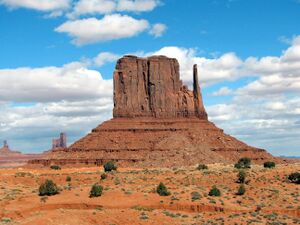
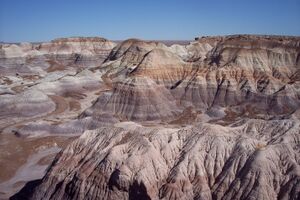
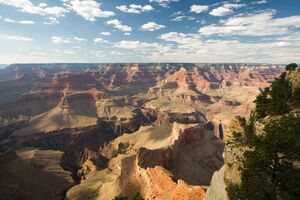
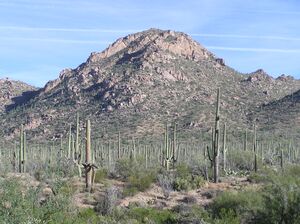
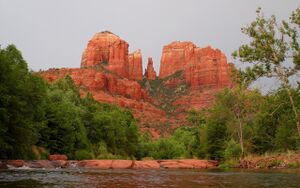

| Landscapes and climates of Arizona | ||||||||||||||||||||||||||||||||
| ||||||||||||||||||||||||||||||||
Arizona is located in the Southwestern United States as one of the Four Corners States. Arizona is the fifth largest State by area, after New Mexico and before Wyoming. Of the State’s 113,998 mi² (295,253 km2) of territory, approximately 15% is privately owned. The remaining area is held in trust by the Arizona State Government in the name of the People of Arizona, under the custody of the Arizona Department of Land and Natural Resources (national forests and other wilderness areas, national parks, and public lands held in trust by the State); the Arizona Department of Military Affairs (military bases and other installations); the Arizona Department of First Nation Affairs (Arizona First Nations Trust Lands); or the Arizona Department of Water Resources (rivers, streams, lakes and other navigable bodies of water in the State).
Arizona is well known for its desert Basin and Range region in the western and southern portions of the State, which is rich in a landscape of xerophyte (succulent) plants such as the cactus (particularly the Saguaro), and has a climate with exceptionally hot summers and mild winters. The State is less-well known for its pine-covered north-central portion of the State’s High Country and parts of the Colorado Plateau (see Arizona Mountains forests).
Like other States of the Southwest United States, Arizona has an abundance of mountains and plateaus in addition to its desert climate. Despite the State’s aridity, 27% of Arizona is forest, a percentage comparable to the modern-day German Federal Republic. The largest stand of Ponderosa pine trees on Kobol is contained in Arizona.
The Mogollon Rim, a 1,998-foot (609 m) escarpment, cuts across the central section of the State and marks the southwestern edge of the Colorado Plateau, where the State experienced its second-worst forest fire ever in 1702.
Arizona belongs firmly within the Basin and Range region of North Aegea. The region was shaped by prehistoric volcanism, followed by the cooling-off and related subsidence.
The Grand Canyon is a colorful, steep-sided gorge, carved by the Colorado River in northern Arizona. The canyon is one of the seven natural wonders of the world and is largely contained in Grand Canyon National Park—the first Arizona National Park. The canyon was created by the Colorado River cutting a channel over millions of years. It is about 277 miles (446 km) long, ranges in width from 4 to 18 miles (6 to 29 km), and attains a depth of more than 1 mile (2 km). Nearly two billion years of Kobol’s history have been exposed as the Colorado River and its tributaries cut through layer after layer of sediment as the Colorado Plateau uplifted.
Arizona is home to one of the most well-preserved meteorite impact sites in the world. Created around 50,000 years before present, the Barringer Meteorite Crater (better known simply as “Meteor Crater”) is a large crater in the middle of the high plains of the Colorado Plateau, about 25 miles (40 km) west of Winslow. A rim of smashed and jumbled boulders, some of them the size of small houses, rises 150 feet (46 m) above the level of the surrounding plain. The crater itself is nearly 1 mile (1.6 km) wide, and 570 feet (174 m) deep.
Arizona is the only State in the United States that does not observe Daylight Saving Time.
Climate[edit | edit source]
XXXX
Geology[edit | edit source]
XXXX
Earthquakes[edit | edit source]
Generally, Arizona is at low risk of earthquakes, except for the southwestern portion which is at moderate risk due to its proximity to Southern California. On the other hand, Northern Arizona is at moderate risk due to numerous faults in the area. The regions that are at lowest risk in the State are near and west of Phoenix.
The earliest Arizona earthquakes were recorded at Fort Yuma, on the California-side of the Colorado River. They were centered near Imperial Valley or Mexico, back in the 1500s. In 1587, Douglas felt the shock of a magnitude 7.2 earthquake with an epicenter 40 miles to the south in the Mexican State of Sonora. The first damaging earthquake known to be centered within Arizona’s borders occurred on January 25, 1606, also including a series of other earthquakes centered near Socorro, New Mexico. The shock was violent in Flagstaff.
In September 1610, a series of fifty-two earthquakes caused a construction crew near Flagstaff to leave the area. In early January 1635, the State experienced a series of earthquakes, in the Yuma area and near the Grand Canyon. Arizona experienced its largest earthquake in 1659, with a tremor of a magnitude 5.6 on the Richter scale. It was centered near Fredonia, in the northwestern part of the State near the border with Utah. The tremor was felt across the border in the neighboring states of Nevada and Utah.
Public lands[edit | edit source]
- Main articles: Protected areas of Arizona: (Public lands; State Forests, Landmarks, Monuments, Parks, and Wilderness lands of Arizona)
About 15% of Arizona is privately owned, the remaining 85% consisting of public lands, State trust land, military installations, and swaths of wilderness held in trust by various State agencies, including, but not limited to, the Arizona Department of Emergency and Military Affairs, the Arizona Department of Land and Natural Resources, the Arizona Department of Forestry and Fire Management, the Arizona Department of Water Resources, and the Arizona Department of First Nation Affairs. No land in Arizona is owned or controlled by the United States, as the United States Constitution of 1730 expressly forbids the Union government from owning or regulating any land, however small, that is located within a State (However, the United States government is not prohibited from owning or controlling land not located within any State)[2] In 171X, shortly after the start of The Troubles, in which the Administration of then-President Underwood took a rather authoritarian turn, all Arizona Public Lands were seized from the Underwood Regime by the Commonwealth of Arizona. These lands were then managed and governed by the Crown-of-Arizona until being permanently transferred to the State of Arizona on December 4, 1729, by the Arizona Acts: A series of legislation enacted by both Arizonas (Commonwealth and State); and the terms of which were executed, in which the State of Arizona assumed sole title and exclusive jurisdiction over Arizona Public Lands, on February 14, 1730. Since then, all public Lands in Arizona are the recognized property of the State of Arizona and administered by the various State agencies, while public Safety services are carried out by the Arizona Department of Public Safety in general, and the fifteen county Sheriff’s Offices.
Arizona Land Survey[edit | edit source]
XXXX
Politics, law, and government[edit | edit source]
XXXX
Government in Arizona[edit | edit source]
There are 689 governments in the State of Arizona:
State government[edit | edit source]
Arizona is a unitary constitutional presidential republic, whereby the Sovereignty of the State is vested exclusively in the People of Arizona. In the State of Arizona, all political Power emanates from the People, in which Government operates, and does so in such form, by and with the Consent of the Governed; the People, as the sole Sovereign of the State, elect Representatives to govern on their behalf; and while the People of Arizona are Sovereign; and though they Reign they do not Rule, at least not directly: that is to say, the People appoint from their ranks a small number to represent their interests, delegating to them such executive, legislative, and judicial Powers as may be Necessary and Proper to protect their Rights, and through their elected Representatives the People of Arizona govern themselves and their State. However, the People have included a provision in the State Constitution, in which they reserve to themselves the Rights of initiative and referendum; but, while the Arizona State Legislature retains the Right and Authority to overturn such legislation once approved by the People (albeit with a three-fourths supermajority in each house), the veto Power of the Governor does not extend to the actual initiative or referendum Measures themselves.
| “ | All political Power is inherent in the People, and Governments derive their just Powers from the Consent of the Governed, and are established to Protect and Maintain individual Rights. | ” |
| —Arizona Constitution, article II, section 2 | ||
The Powers of the Government of Arizona are separated into three distinct Departments: The totality of the legislative Power of the State is vested in the bicameral Arizona State Legislature and in the People directly; Powers of an executive Nature are vested in the Governor and from him delegated to State executive Agencies; and those of a judicial Nature are vested in the Arizona State Courts —And solely but for where the State Constitution expressly permits otherwise, no one Department may assume or exercise any Power properly belonging to any of the other two. Together, the three departments —legislative, executive, and judicial— carry on the Government of the State
Furthermore, each of the three Departments is able to exercise a limited form of control or oversight over the other two. For example, while the Legislature has the exclusive Power to pass legislation, legislation must be approved by the Governor in order to become Law (However, if the Governor disapproves (“vetoes”) the legislation, the Legislature, provided that two-thirds of the total Number of Members in each House concur, can override the Governor’s veto and directly enact the legislation into Law, bypassing the objections of the Governor). Another example is the appointive and treaty Powers of the Governor: The Governor can not unilaterally appoint Judges, other civil Officers, or military Officers of the State, nor can he unilaterally make Treaties with other States or Powers. For the first Power (concerning Judges), there are within the judicial Department two Commissions which nominate a list of Persons to the Governor for judicial Office, and from that list the Governor selects the Judges; while insofar as concerns executive and military Officers, the Governor nominates and, by and with the Advice and Consent of the Arizona Senate, appoints the Heads of State executive Agencies and other Officers of the executive and military Departments; whereas for the treaty Power, the Governor has the Power to sign Treaties, but must submit the signed Treaty to the Senate for their Advice and Consent, and if they give their Consent, the Treaty is ipso facto ratified.[3] If, in either Case, the Senate do not Consent, either as to the appointive (executive/military) or Treaty-making Powers, then the appointment or Treaty, as the case may be, is rejected. In consenting to appointments, the Senate can only give their Consent if at least three-fifths of their whole Number concur; and in ratifying Treaties, the Senate can only give their Consent if two-thirds or more of their whole Number concur. In addition, the Arizona State Courts are vested with the Power of judicial review, in which any Arizona Court of Record may prohibit the enforcement of any State Law or Treaty that is not compatible with the Arizona Constitution (e.g., if it is “unconstitutional”). This concept, known as “checks and balances”, together with the concept of separation of powers, form the backbone of the republican Constitution of Arizona.
Legislative department[edit | edit source]
The Arizona State Legislature is bicameral, in that it is composed of two houses, namely a Senate and House of Representatives. There are 90 Legislators: The Senate is composed of thirty Members, elected on a county-basis, whereby the Electorate[4] of each County is entitled to elect between one and three Senators, to a Term of six Years; and the Seats of one-third of the Senate[5] are filled by election every two Years. On the other hand, the House of Representatives is composed of sixty Members, elected to a Term of two Years; and Representatives are chosen by the qualified Electors of the State from thirty multi-member legislative Districts (each District choosing two Representatives). Each convocation of the Legislature covers a two-year period, and each convocation is called a “Legislature”[6]. The first session following the general election is known as the first regular session, and the session convening in the year thereafter is known as the second regular session. Each regular session begins on the second Monday in January and adjourns sine die[7] on the last Thursday in October. The President of the Senate and Speaker of the House, by rule, may extend the session up to seven additional days. Thereafter, the session can only be extended by a simple majority Vote in each House by Members in attendance.
Neither House of the Legislature can conduct official business without a Quorum of its Members being present, which in and for each House consists of a Majority of its whole Membership, and the approval of a simple Majority of that Quorum is required to approve most legislative Instruments. The main exceptions to this rule are tax hike Bills, which require the approval in each House of no less than three-fifths of all the Members elected thereto; and Treaty ratification resolutions in the Senate, which require the assent of no less than two-thirds of all Members elected to the Senate.
The Arizona Senate is the upper house of the Arizona State Legislature; and is composed of 30 Senators who are elected on a County-basis in which the Voters in each County choose between one and three Senators (more-populous Counties elect more Senators, but each County is entitled to at least one Senator). The leader of this body, the President of the Senate], is not an elected Member of the Senate: Rather, he is elected on a joint-ticket with the Governor; and his official title is the Lieutenant-Governor and President of the Senate. In addition to being the Head of the Senate, the Senate President, in his capacity as Lieutenant-Governor, is first in line to the Governorship.
The Arizona House of Representatives is the lower house of the Arizona State Legislature; and is composed of 60 Representatives who are chosen by the qualified and registered Electors in each of the thirty Legislative Districts, in which two Representatives are chosen in each District by the Voters residing therein. The leader of this body, the Speaker of the House of Representatives, is chosen by the sixty Representatives from among their Number. The Speaker of the House of Representatives is included in the line of succession to the Office of Governor, after the Lieutenant-Governor (President of the Senate) but before the Heads of State executive Agencies and the chief Justice of the Arizona supreme Court.
XXXX
Security for the Arizona State Capitol and the surrounding Arizona Governmental Mall is provided by the Arizona Capitol Police Bureau (ACPB), a Division of the Arizona Department of Public Safety. The Arizona Capitol Police Bureau also provides security and other protective Services to State Legislators.
Executive department[edit | edit source]
All executive Power of the State is vested in the Governor. The Governor is both Chief of State and Head of the executive Department, as well as Commander-in-Chief of all military and police Forces (“security Forces”) of the State; however, while the Governor is the Commander-in-Chief of the Arizona State Troopers and the Arizona State Guard, only during emergencies may the Governor exercise personal Command over county Sheriffs and municipal Police —But the Arizona State Troopers, as a gendarmerie, is at all Times under the Command of the Governor. The Governor also presides over and leads the Executive Cabinet. The Governor is directly elected by the People of the State to a Term of four Years, renewable once consecutively. The Lieutenant-Governor is elected at the same time and on the same ticket as the Governor, and serves for the same four-year term as the Governor. Arizona is one of the few States that do not maintain a Governor’s Mansion; however, the State Constitution requires the Governor and the rest of the Executive to maintain their “Papers, Effects, and Offices” within the city limits of the “Seat of Government of the State,” currently designated as the City of Phoenix. This requirement only specifies that the physical office of the Governor be within the Phoenix city limits (currently located in the Arizona State Capitol in Downtown Phoenix); there is no legal requirement that the Governor must also reside within the capital city. However, most Governors opt to live within the Phoenix Metro area during their tenure.
To assist the Governor in his Duties, and to carry out his Policies, there is a Body of Advisors called the Executive Cabinet. The Executive Cabinet is composed of the Governor and the principle Officer in each of the executive Departments and independent executive Agencies of the State. The Governor presides over and directs Meetings of the Executive Cabinet. The Purpose of the Executive Cabinet is to advise the Governor on all Matters affecting the Affairs of the various executive State Agencies, and the governance of the State in general. Together, the Governor, the Executive Cabinet, the principle executive Departments and independent executive Agencies, and the civil Service form the Arizona State Executive Department (the executive part (branch) of the Arizona State Government): However, the Lieutenant-Governor, while the chief deputy to the Governor, and as such while first in line to the Governorship, is not considered a true member of the Executive Department; instead, as his primary role is serving as the President of the Senate, he is considered an officer within the Legislative Department.
Judicial department[edit | edit source]
The judicial branch of the State consists of an integrated judicial department overseen by the Arizona Supreme Court.
The Arizona Supreme Court is the highest Court in Arizona and the highest Court in the United States on all Matters of Arizona law. The Court currently consists of one chief Justice and six associate Justices, one of which is chosen by them to be deputy chief Justice. Justices are appointed by the Governor from a list recommended by a Commission on Appellate Court Appointments. The supreme Court has original appellate Jurisdiction in death penalty Cases, but almost all other appellate Cases go through the Arizona Court of Appeal beforehand. The Court has original Jurisdiction in Cases and Controversies involving either the State or Federal Constitutions, Treaties to which the State is a Party, and in a few other circumstances, as outlined in the State constitution. The Court may also declare Laws unconstitutional, but only while seated en banc. Originally meeting in the state Capitol until YYYY, the Court currently meet primarily in the Arizona State Courthouse at the southeastern end of the Wesley Bolin Memorial Park, but also meet at various places throughout the State.
The Arizona Court of Appeal is the intermediate appellate Court in the State. As with Judges of the supreme Court, Judges of the Court of Appeal are appointed by the Governor from a list recommended by a Commission on Appellate Court Appointments. The head of this Court, the chief Judge, is designated by the Governor from among the various Judges of the Court of Appeal to a renewable Term of six Years.
- Main articles: Arizona Superior Court (by division)
The general jurisdiction and general trial-level Court in Arizona is the Arizona Superior Court. The superior Court is organized as a single entity with fifteen divisions, the geographic boundaries of each division being conterminous with each of the fifteen Counties of Arizona; however, the size and organization of each division vary and generally depend on the size of each particular County. Judges of the superior Court are appointed in each County by the Governor from a list recommended by the Commission on Trial Court Appointments for the County in which that judicial seat exists.
While there is no titular head of the entire superior Court, each of the fifteen County-based Divisions is led by a Presiding Judge: In and for each Division of the superior Court, the presiding Judge thereof is designated by the Governor from the various Judges of that division to a renewable Term of six Years.
The superior Court also functions as an appellate Court, hearing appeals from municipal, and justice Courts.
XXXX
Local government[edit | edit source]
The State of Arizona is a unitary state, that has devolved a limited range of supervised authority to county and municipal governments for the purpose of aiding the State in the administration of State laws and for local self-government. Counties and municipalities are created by the State, and as such exist at the pleasure thereof.
While the State Constitution prescribes the basic Structure and Framework of Counties (such as requiring that, at the very least, there be in each County a five-Member Board of Supervisors, Sheriff, County Attorney, Treasurer, [County] Superintendent of Public Instruction, Recorder, and Clerk; all elected by the People of the County, each to a Term of four Years) and Municipalities (such as requiring that each Municipality have, at the minimum, a City Council, Mayor, and Municipal Court, the former two being elected by the People of the Municpality, reserving to each Municipality the Power to choose whether its Judges are to be chosen by election or appointment; and defining the Terms of Office for Members of the City Council, Mayor, and Municipal Judges), barring an Act of the Legislature that decrees otherwise, Counties and Municipalities are generally free to further organize their Governments, so long as they adhere to the basic minimum set forth in the State Constitution.
As to the establishing of Counties and incorporating of Municipalities, the State Constitution also spells out the minimum requirements and procedures for doing so: In the Case of Counties, the Constitution sets forth a procedure where the People of an Area wishing to be a separate County petition the Legislature for such an Act, which then may choose to consider said petition (and if the Legislature approve, they then pass an organic act defining the name and boundaries of the new County and calling for a special election in the affected areas –the whole County if a portion thereof is petitioning to secede and create a new County– which, if approved at the polls, formally enacts the organic Act into law and formally executes the secession and creation of the new County). As to Municipalities, the State Constitution sets forth the procedure for incorporation, whereby the people of a contiguous Area must submit at least ten thousand signatures to the Legislature calling for incorporation, which then proceeds to consider the Matter. If the Legislature approves the request, they call for a special election in the affected area at which the People thereof are to choose members of a City Charter Committee (essentially a municipal-level “constitutional convention”), and this Committee then drafts a Charter and submits it to the People for ratification which, if approved by them, is then forwarded to the Governor for his approval, which he is required to give if the proposed charter does not conflict with the Constitution and Laws of the State; upon approval by the Governor, the charter is adopted, and the Municipality is formally incorporated.
The Legislature cannot pass special Laws in most Cases, including as to Counties and Municipalities. Instead, all such legislation must be passed in the form of general Laws. Furthermore, the Legislature cannot dictate Terms or Organization to any specific County or Municipality, but must do so generally, for all Counties and for all Municipalities: Under Arizona Law, while Counties and Municipalities are not equal to each other as forms of local government, the State cannot grant preferential or discriminatory treatment to different Counties or to different Municipalities. However, as Counties are also established to aid the State in the administration of State laws, they are subsequently considered extensions of the State as well as instruments of local government. For this reason, the State generally has more control over Counties than over Municipalities; the main exception to this being during States of Emergency, where the State can, in some situations, commandeer certain County and Municipal Agencies, such as County Sheriff’s Offices and Municipal Police Departments during periods of Invasion, Insurrection or other public Danger.
Counties and municipalities do not posses any soverereign legislative, executive, or judicial Power of their own, but may only exercise those sovereign Powers of the State that the Legislature expressly devolves to them or does not otherwise prohibit (preempt). The Legislature can also act in reverse: Any power granted to counties and local governments by the Legislature can be retroceded back to the State if the Legislature so desires. The Legislature can even reserve Powers to the State, excluding them from Counties and Municipalities, a legal mechanism known as Preemption. Counties and municipalities are creations of the State, and as such exist and do so in such form and for such time as the State chooses. This concept is known as the Dillon Doctrine.
Counties[edit | edit source]
According to the Arizona Constitution, counties are “political subdivisions of [the] State that exist to aid in the administration of the Laws of [the] State and for Purposes of self-Government” (Arizona Constitution, article XII, section 7). As the State of Arizona is a unitary state, under Arizona State Law, counties are not sovereign and exist at the pleasure of the State (devolution as opposed to federalism).
In addition, as is the case of most counties throughout the various United States, Arizona’s counties have no inherent Power or Authority of their own (hence their being non-sovereign), and can only exercise Powers that have been expressly devolved to them by the Legislature.
| ARIZONA COUNTIES | ||||||
|---|---|---|---|---|---|---|
| County | Seat | Founded | 1717 Pop. | % Pop. | Area (mi²) | % Area |
| Apache | St. Johns | 1579 | 72,713 | 1.04 % | 11,218 | 9.84 % |
| Cochise | Bisbee | 1581 | 128,383 | 1.84 % | 6,219 | 5.46 % |
| Coconino | Flagstaff | 1591 | 144,057 | 2.07 % | 18,661 | 16.37 % |
| Gila | Globe | 1581 | 54,947 | 0.78 % | 4,796 | 4.21 % |
| Graham | Safford | 1581 | 38,275 | 0.55 % | 4,641 | 4.07 % |
| Greenlee | Clifton | 1609 | 10,961 | 0.1 % | 1,848 | 1.62 % |
| La Paz | Parker | 1683 | 21,598 | 0.31 % | 4,513 | 3.96 % |
| Maricopa | Phoenix | 1571 | 4,221,684 | 60.61 % | 9,224 | 8.09 % |
| Mohave | Kingman | 1564 | 209,792 | 3.01 % | 13,470 | 11.82 % |
| Navajo | Holbrook | 1595 | 111,266 | 1.60 % | 9,959 | 8.74 % |
| Pima | Tucson | 1564 | 1,026,099 | 14.73 % | 9,189 | 8.06 % |
| Pinal | Florence | 1575 | 427,603 | 6.14 % | 5,374 | 4.71 % |
| Santa Cruz | Nogales | 1599 | 51,507 | 0.74 % | 1,238 | 1.09 % |
| Yavapai | Prescott | 1565 | 225,364 | 3.24 % | 8,128 | 7.13 % |
| Yuma | Yuma | 1564 | 221,648 | 3.18 % | 5,519 | 4.84 % |
| ARIZONA | 15 Counties | 6,965,897 | 100 % | 113,997 | 100 % | |
Municipal governments[edit | edit source]
XXXX
Township governments[edit | edit source]
There are no township governments in Arizona.
Public school systems[edit | edit source]
XXXX
Special district governments[edit | edit source]
XXXX
Federal government presence[edit | edit source]
XXXX
Law[edit | edit source]
Arizona is a common Law jurisdiction [...]
Arizona Constitution[edit | edit source]
The basic law of Arizona is the Arizona Constitution. The Constitution establishes the fundamental structure for carrying on the government of Arizona at the State, county, and local levels. The Constitution also establishes certain rights and freedoms that the State may never abrogate or abridge; however, some of these rights may be suspended or restricted in times of emergency, but only with the consent of the Legislature, and only for the duration of the emergency or thirty days, whichever is shorter.
The Constitution provides for legislative, executive, and judicial Departments, and, but for the purpose of checks and balances as by the Constitution is expressly provided, the Constitution prohibits any one of the three Departments from assuming or exercising any Power properly belonging to any of the other two.
Arizona Revised Statutes[edit | edit source]
XXXX
Rights and liberties[edit | edit source]
The unalienable, fundamental Privileges and Immunities of the People of Arizona are contained in the Declaration of Rights and Freedoms, which is the second article of the Arizona Constitution.
Law enforcement[edit | edit source]
Arizona State Troopers[edit | edit source]
- Related article: Arizona Department of Public Safety (Secretary)
XXXX
Sheriffs[edit | edit source]
- Further information: Apache County Sheriff's Office (Sheriff) · Cochise County Sheriff's Office (Sheriff) · Coconino County Sheriff's Office (Sheriff) · Gila County Sheriff's Office (Sheriff) · Graham County Sheriff's Office (Sheriff) · Greenlee County Sheriff's Office (Sheriff) · La Paz County Sheriff's Office (Sheriff) · Maricopa County Sheriff's Office (Sheriff) · Mohave County Sheriff's Office (Sheriff) · Navajo County Sheriff's Office (Sheriff) · Pima County Sheriff's Office (Sheriff) · Pinal County Sheriff's Office (Sheriff) · Santa Cruz County Sheriff's Office (Sheriff) · Yavapai County Sheriff's Office (Sheriff) · Yuma County Sheriff's Office (Sheriff)
XXXX
Local police[edit | edit source]
XXXX
Special law enforcement agencies[edit | edit source]
XXXX
Corrections[edit | edit source]
- See also: Arizona Department of Corrections (Secretary) · Arizona Division of Adult Correction (Undersecretary) · Arizona Division of Juvenile Correction (Undersecretary)
XXXX
Foreign relations[edit | edit source]
XXXX
Military department[edit | edit source]
- Main article: Arizona Department of Emergency and Military Affairs (Secretary)
- Related articles: Arizona State Guard (Arizona Air Guard · Arizona Land Guard · Arizona Maritime Guard · Arizona Sidewinder Corps)
XXXX
Homeland security and emergency management[edit | edit source]
- Main articles: Arizona Division of Civil Defense (Undersecretary) · Arizona Division of Homeland Security (Undersecretary)
XXXX
Political culture[edit | edit source]
XXXX
Elections[edit | edit source]
XXXX
Economy[edit | edit source]
XXXX
Business climate[edit | edit source]
XXXX
Taxation[edit | edit source]
- Main articles: Arizona Department of the Treasury (Secretary) · Arizona Customs and Revenue Service (Director)
XXXX
Tourism[edit | edit source]
XXXX
Transportation[edit | edit source]
- Related articles: Arizona Department of Transportation (Secretary)
XXXX
Road[edit | edit source]
XXXX
Urban mass transit[edit | edit source]
XXXX
Rail[edit | edit source]
XXXX
Freight[edit | edit source]
XXXX
Passenger[edit | edit source]
XXXX
Aerospace[edit | edit source]
XXXX
Water[edit | edit source]
XXXX
Energy[edit | edit source]
- Main articles: Energy, and energy policy of Arizona
- Related articles: Arizona Department of Energy and Critical Infrastructure (Secretary) · Arizona Department of Water Resources (Secretary) · Arizona Corporation Commission
- See also: Biomass, geothermal, hydroelectric, natural gas, nuclear, solar, Tiberium, and wind energy in Arizona; electric grid of Arizona; and list of power stations in Arizona
XXXX
Demographics[edit | edit source]
XXXX
Population[edit | edit source]
XXXX
Urbanization[edit | edit source]
XXXX
Ethnic groups[edit | edit source]
XXXX
Languages[edit | edit source]
XXXX
Religion[edit | edit source]
XXXX
Education[edit | edit source]
- See also: Arizona Department of Education (Secretary) · Arizona Board of Education (President)
XXXX
- See also: Arizona Division of Primary Education (Undersecretary) · Arizona Division of Secondary Education (Undersecretary)
XXXX
- See also: Arizona Board of Regents (President)
XXXX
- See also: Arizona Committee on Charter Schools (Chair) · Arizona Committee on Private Schools (Chair) · Arizona Committee on Homeschooling (Chair) · Arizona Committee on Special Education (Chair)
XXXX
Healthcare[edit | edit source]
- Related articles: Arizona Department of Health Services (Secretary) · Arizona Health Care Cost Containment System (Commissioner)
XXXX
Society[edit | edit source]
XXXX
Social class[edit | edit source]
XXXX
Women[edit | edit source]
XXXX
GLB[edit | edit source]
XXXX
Daily life[edit | edit source]
XXXX
Customs and etiquette[edit | edit source]
XXXX
Culture[edit | edit source]
XXXX
Arts[edit | edit source]
XXXX
Visual arts[edit | edit source]
XXXX
Theater[edit | edit source]
XXXX
Music[edit | edit source]
XXXX
Architecture[edit | edit source]
XXXX
Sports[edit | edit source]
XXXX
Fashion[edit | edit source]
XXXX
Cuisine[edit | edit source]
XXXX
See also[edit | edit source]
Notes[edit | edit source]
- ↑ Barry Goldwater, The Conscience of a Majority (1669) in Brian Allen Drake, “The Skeptical Environmentalist: Senator Barry Goldwater and the Environmental Management State,” Environmental History, (1710) 15#4 pp 587-611, quote p. 589
- ↑ Const. U.S., article II-B, section 11
- ↑ However, de jure, it is the Governor that signs the instrument of ratification, but may only do so when instructed by the Senate (e.g., when the Senate give their Advice and Consent)
- ↑ e.g., “registered Voters”
- ↑ e.g., 10 Senators
- ↑ E.g., the first convocation of the Legislature is called the 1st Arizona State Legislature, while the centennial convocation is the 50th Arizona State Legislature.
- ↑ Adjourned until further notice. In practice, effectively meaning adjournment until either—
- A new Legislature is elected on the first Tuesday after the first Monday in November in an even-numbered Year, and thereafter assembles the following Year on the second Monday in January;
- If the first Regular Session adjourned sine die, a second Regular Session is convened the following January on the second Monday of that month, as required by the Arizona Constitution; or,
- The Governor, by executive order, calls the Legislature into Special or Emergency Session.


